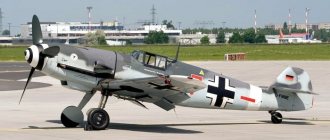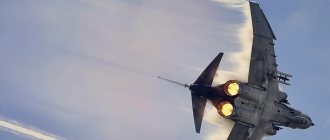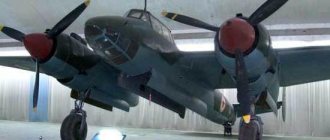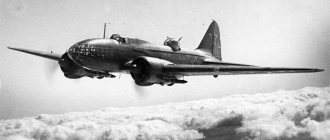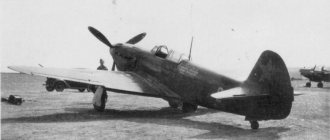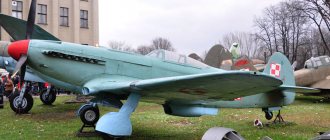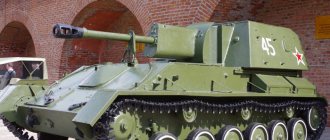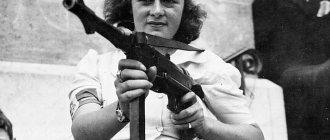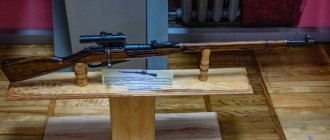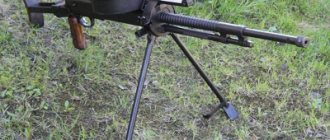I am a “Yak” fighter, my engine is ringing, The sky is my abode, And the one who sits inside me Believes that he is a fighter.
Vladimir Vysotsky
The first two years of the war became a difficult test for the Red Army and the entire Soviet state. Military equipment created in the pre-war period - tanks, artillery systems, airplanes - was also subjected to the most serious examination. Only by 1942 was Soviet industry able to switch to a war footing and significantly increase production output. The evacuated factories began to operate, and supplies of strategic materials and equipment under Lend-Lease were established.
In the first months of the war, the managers of defense factories were given only one task: to maximize the number of products produced; any changes in the design of weapons and military equipment were rejected if they reduced their output. Despite this attitude, it was no longer possible to ignore the experience gained at the front and during mass production.
The Yak-9 became the fourth (after the Yak-1, Yak-3 and Yak-7) fighter aircraft of the Second World War, developed by the designers of the Yakovlev Design Bureau. During its creation, all the experience of using fighter aircraft at the initial stage of the war was taken into account. In fact, the Yak-9 aircraft was a continuation of the Yak-7 fighter (it was very similar in appearance), but structurally this machine was much more advanced.
The Yak-9 aircraft is the most popular Soviet fighter of the war period. Its production began in October 1942 and continued until 1948. During this period, 16,769 aircraft were produced. This machine was in service until 1950. In addition to the Soviet Air Force, the Yak-9 was used by the air forces of Bulgaria, Poland, Albania, Hungary, Yugoslavia, China and the DPRK. There is information about the supply of these fighters to the USA and Great Britain.
In 1944, there were more Yak-9 aircraft of various modifications at the front than any other fighters combined. The production of the aircraft was established at four aircraft factories: No. 153 (Novosibirsk), No. 166 (Omsk) and No. 82 (Moscow). At its peak, fighter production at Factory No. 153 reached twenty aircraft per day.
During the serial production period, more than twenty modifications of the fighter were manufactured, fifteen of which went into series. The Yak-9 was good for its versatility: different modifications of this vehicle could perform various tasks, including a fighter-bomber, front-line fighter, high-altitude interceptor, and long-range escort fighter. The Yak-9 fighter was equipped with five different types of engines, the aircraft had six modifications with different volumes of fuel tanks and seven weapons options.
The Yak-9 took part in all the most important battles of the war, starting with the Battle of Stalingrad. It is almost impossible to overestimate the contribution of this machine to the victory over Nazi Germany. Ease of operation, high firepower and good performance characteristics of this fighter largely contributed to the conquest of air supremacy by the Soviet Air Force. The Yak-9 eliminated most of the structural and technological defects that were characteristic of its predecessors. The Yak-9 also took part in the war on the Korean Peninsula.
However, before moving on to the review of the Yak-9, it is necessary to say a few words about the history of its creation, as well as about the modifications that this famous machine had.
History of creation
The experience of the initial period of the war clearly showed that the main problem of the Yak fighters was the insufficient power supply compared to German fighters (the ratio of the power of the power plant to the weight of the aircraft). It was for this reason that they were inferior to their opponents Bf-109F and Bf-109G in vertical maneuver and rate of climb.
This problem could be solved in two ways: reduce the weight of the aircraft or install a more powerful engine on it. Increased the speed characteristics of the aircraft and improved the aerodynamic qualities of the machine. The first path was taken when creating the Yak-3 fighter; it was made as lightweight as possible by reducing the volume of fuel tanks and a shortened wing. However, such modernization sharply reduced the practical range of the aircraft and its time in the air.
Another effective and simple way to lighten the fighter was to completely replace all wooden elements in its design with metal (duralumin). However, at the beginning of the war, the USSR experienced a severe shortage of “winged metal”. The situation began to change for the better only towards the end of 1942. This allowed the designers of the Yakovlev Design Bureau to begin creating a new, faster fighter.
It was based on the Yak-7B serial aircraft, on which the M-105PF engine was installed. The designers carefully analyzed the elements of the fighter for possible weight reduction and improvement of the aerodynamic qualities of the vehicle. The wooden wing spars were replaced with duralumin ones. This change alone made it possible to reduce the total weight of the structure by 150 kg. To further lighten the vehicle, one UBS machine gun was removed from it, and to improve visibility from the cockpit, the garrot was lowered and a new canopy was installed.
On June 26, 1942, a prototype aircraft, designated Yak-7DI, took to the skies for the first time. The test results encouraged the designers: the new fighter was superior to the Yak-7B in flight range, showed better maneuverability and climb rate. State tests were completed on August 5, the fighter was put into service under the name Yak-9.
Serial production of the Yak-9 began in October 1942, first production was established at Novosibirsk plant No. 153 (it went in parallel with the Yak-7B), and later Omsk plant No. 166 began production of the Yak-9.
The first Yak-9 fighters appeared at the front at the end of 1942, during the Battle of Stalingrad, but their number was insignificant. New vehicles began to be delivered en masse to combat units only in the spring of 1943. The first battle in which the Yak-9 was used more or less en masse was the Battle of Kursk.
The first experience of operating the fighter revealed some shortcomings, most of which were associated with the low quality of the machines. In particular, there were frequent cases of the wooden wing skin being torn off from the load-bearing frame. Teams of repairmen were sent to the front, who, together with the technical personnel of the combat units, eliminated the problems.
By the beginning of the Battle of Kursk, the Yak-9 was in service with five fighter air divisions, and by the end of July 1943, the 11th mixed air corps, which included three regiments armed with the Yak-9, was added to them. The plane had good aerobatic qualities and excellent maneuverability, and was easy to fly. However, in terms of speed characteristics, it was inferior to the best German fighters Bf 109G and Fw 190A. The reason was simple - German cars had more powerful engines. Another drawback of the Yak-9 was its insufficient armament, which many famous pilots mentioned in their memoirs.
Already in the summer of 1943, two new modifications of the vehicle were created - the Yak-9D and Yak-9T. About the last of them it is necessary to say a few words separately. The letter “T” in the designation of the vehicle means “heavy” and this definition refers not to the weight of the fighter, but to its armament - the 37-mm NS-37 aircraft cannon. To install it on the plane, it was necessary to change its design, but it was worth it. Previously, in order to shoot down a strong German twin-engine bomber, the pilot sometimes had to expend all the ammunition; a 37-mm gun could accomplish this task in a dozen shots. Later, the Yak-9T was used very effectively against enemy armored vehicles and ships in the Black Sea.
True, there were comments about the new weapon. Its rate of fire was unsatisfactory for an aircraft gun, and significant recoil reduced firing accuracy. The Yak-9T was perfect for pilots who could shoot well, but there weren’t that many of them.
At the end of the war, the Yak-9 was the main fighter of the Soviet Air Force. After its completion, the USSR supplied these aircraft to its allies in Eastern Europe and Asia.
Operation of the Yak-9 fighter
The Yak-9 fighter is the most popular domestic and the most numerous front-line fighter of the countries of the anti-Hitler coalition. It was first used at Stalingrad in 1942 and since then has participated in all battles of the Great Patriotic War. French pilots from the Normandy regiment fought on the Yak-9, and after the war it was in service with the armies of Albania, Bulgaria, Hungary, China, North Korea, Poland and Yugoslavia.
One of the Yugoslav Yak-9Ts was subsequently acquired by Great Britain; the commander of the 239th Fighter Wing of the Royal Air Force, D. Storrer, flew it in 1945-1947. The Yak-9P fighters of the Chinese and DPRK Air Forces were used during the Korean War until the end of 1950, and the final service of the Yak-9 aircraft of later modifications in some countries ended only by the 1960s of the 20th century.
The Yak-9 was mass-produced from August 1942 to December 1948, during which time 16,769 aircraft of all modifications were manufactured.
• Aviation Directory • Aircraft of the same period • Soviet fighters •
Source: compilation from open sources on the Internet, as well as from the book “History of Aircraft Designs in the USSR. 1938-1950,” Shavrov V.B.
Modifications
One of the main advantages of the Yak-9 was the high versatility of this aircraft. It was easily modified into combat vehicles designed to perform a wide variety of missions. There were fifteen serial modifications of the fighter in total, some of them are described below:
- Yak-9D. Modification with an increased fuel supply (480 kg, instead of 320 for the Yak-9). The aircraft had four fuel tanks - two root tanks and two located in the wing consoles; the flight range was increased to 1400 km. Serial production of the vehicle began in the spring of 1943 and continued until mid-1944. During this time, 3068 fighters of this modification were manufactured. Reviews about this modification are quite contradictory: operation has shown that additional fuel is often simply not needed, so some of the tanks were closed with plugs.
- Yak-9T. A fighter variant armed with a 37 mm NS-37 cannon, which was mounted in the camshaft. Due to its considerable length, the cockpit was moved back by 400 mm, and the aircraft structure was strengthened. The gun's ammunition capacity was 30-32 shells. In addition to the NS-37, the Yak-9T was equipped with one UB synchronous machine gun. This modification of the fighter was quite successfully used to destroy ground targets. An armor-piercing 37 mm projectile penetrated 30 mm thick armor from 500 meters. Production of the aircraft began in March 1943 and continued until mid-1945, with a total of more than 2,700 aircraft produced.
- Yak-9TD. This is another modification with an increased fuel reserve; mass production began in 1944.
- Yak-9K. Another “armor-piercing” modification of the “nine”, created on the basis of the Yak-9T aircraft. This fighter was equipped with a 45-mm NS-45 cannon. To reduce the recoil of the gun, a muzzle brake was installed on it. Despite this, during firing the fighter turned and tossed a little; it was recommended to shoot only in short bursts. In one second, the Yak-9K ejected 5.53 kg of metal. The modification was produced in April-June 1944; a total of 53 aircraft were built. The fighter did not go into large production due to the unreliable operation of the gun.
- Yak-9TK. A modification with a reinforced design and weapon mounting system, which made it possible to install a ShVAK, NS-37, VYa-23 or NS-45 cannon on it, depending on the specific tasks facing the fighter. The modification was developed in the second half of 1943.
- Yak-9M. This fighter model can be called a further development of the Yak-9D. The aircraft had a fuselage with a cockpit moved back by 400 mm (as on the Yak-9T). In 1944, a more powerful VK-105PF-2 engine began to be installed on the vehicle, which somewhat improved its performance characteristics. The Yak-9M is one of the most popular modifications of the fighter; a total of 4,239 aircraft were produced.
- Yak-9DD. A fighter specially designed to accompany long-range bombers of the Tu-2 type. The Yak-9DD was used in joint operations with the allied aviation of the anti-Hitler coalition. The fighter had eight fuel tanks located in the wings, with a total fuel supply of 630 kg. The vehicle was equipped with more advanced instrumentation and navigation equipment, allowing it to fly long distances in different weather conditions. The Yak-9DD's flight range was 1,800 km, and it weighed 3,390 kg. The armament remained the same: a 12.7 mm machine gun and a 20 mm cannon.
- Yak-9R. Basic fighter model, converted into a short-range reconnaissance aircraft. Photographic equipment was installed in the free compartment. It was mass-produced at aircraft factories, in small batches, and serial Yak-9s were also converted into reconnaissance aircraft in aircraft repair shops. There was another reconnaissance aircraft, created on the basis of the Yak-9D fighter, which can be called a long-range reconnaissance aircraft.
- Yak-9B. A modification of the Yak-9D, which can be called a fighter-bomber. The bomb bay was located behind the pilot's cabin; it could hold four hundred-kilogram bombs or four cassettes with anti-tank cumulative bombs. A total of 109 aircraft of this modification were produced.
- Yak-9PD. A high-altitude interceptor aircraft designed specifically for Moscow air defense. Work on this fighter began back in 1942, after German Ju-86r-1 reconnaissance aircraft began to appear over the capital. For a very long time it was not possible to debug the fighter's power plant; its normal operation was achieved only in the spring of 1944. But at this time the Germans had no time for reconnaissance flights over Moscow. A total of 35 vehicles of this modification were produced.
- Yak-9U. A modification of the aircraft that appeared at the end of 1943. In fact, there were two versions of the Yak-9U fighter - with the M-107A engine and the M-105PF-2. In addition to installing a new engine, other changes were made to the design of the fighter. The oil cooler was moved from under the hood to the central part of the wing, the rear part of the fuselage was sheathed with plywood instead of canvas, and the sealing of the vehicle was improved. The armament of both fighters included a cannon in the engine camber (20 or 23 mm) and two 12.7 mm machine guns. Its production began in April 1944. Later the cooling system was modernized.
- Yak-9UT. The fighter, created on the basis of the Yak-9U modification, was distinguished by more powerful weapons. This combat vehicle was armed with three cannons: a central NS-37 (37 mm) and two synchronized B-20 (20 mm). In a second, the fighter could release 6 kg of deadly metal at the enemy. Production of the Yak-9UT began in February 1945; a total of 282 aircraft were produced. They managed to get to the front literally in the last days of the war.
- Yak-9 "Courier". A modification of an aircraft designed to carry one passenger (usually a courier). A place for it was equipped in the rear cabin.
Ya-9B
The Yak-9B fighter-bomber was built on the basis of the 9D model. In the space behind the pilot's cabin, a bomb bay was equipped, consisting of four pipes in which four 100-kilogram bombs or four cassettes containing 32 cumulative anti-tank bombs could be placed. Testing of the bomber began in March 1944. Based on the results of combat missions, the Yak-9B destroyed 29 tanks, 22 armored personnel carriers, 1014 vehicles, 161 railway cars, 20 railway station buildings, 7 guns, 18 steam locomotives and 4 fuel depots. In total, Soviet enterprises produced 109 such bombers.
Description of design
The Yak-9 is a single-seat, single-engine piston monoplane with a low-mounted cantilever wing and a tricycle landing gear retractable in flight. The aircraft had a mixed design made of wood, duralumin, plywood and canvas.
The fuselage of the fighter had a frame made of chromansil pipes, to the front of which a motor mount was attached. The skin of the forward part of the fuselage was made of metal, the tail part of the vehicle was sheathed with plywood. In the central part of the fuselage there was a pilot's cabin, which had a fairly rich set of equipment. The pilot was protected in front and behind by armored glass, and there was also an armor plate installed behind the back of the seat. The central part of the lantern was resettable.
The Yak-9 wing had a modified Clark-YH profile; its design consisted of two duralumin spars, a set of wooden ribs and stringers, as well as a working plywood skin of quite considerable thickness. The top of the casing was covered with canvas using epoxy glue. The wing mechanization consisted of brake flaps and ailerons. Their frame was also made of duralumin. The ailerons were controlled using rods, and the flaps were released by a pneumatic system. In the wing of the aircraft there were two (on other modifications there were four or even eight) fuel tanks, which had a special coating on the inside that covered the holes.
The Yak-9 had an empennage of a mixed design, with metal spars and ribs, but the skin partly consisted of plywood and canvas. The rudders were controlled by rods.
The fighter had a tricycle landing gear, the main struts of which were retracted using a pneumatic system. If it broke, the landing gear could be extended and retracted manually.
The Yak-9 was equipped with a water-cooled M-105PF engine with twelve cylinders and a rated power of 1260 hp. With. The fighter was equipped with a metal three-blade propeller VISH-61P with variable pitch.
The Yak-9's armament consisted of a central cannon located in the engine camber and a synchronized machine gun that fired through the plane of the propeller. Initially, the Yak-9 was equipped with a ShVAK gun (20 mm) and a UBS machine gun (12.7 mm). In subsequent modifications of the vehicle, the armament was repeatedly enhanced.
In 1943, the collimator sights on the Yak-9 were replaced with primitive ring sights on the BB-1. They consisted of a frame with a crosshair made of wire and a front sight mounted on the hood of the fighter. The pilots generally perceived this “primitivization” positively, because domestic collimator sights were of very low quality.
Surviving aircraft[edit]
Yak-9 on display at the Aviation Museum
Bulgaria
- Yak-9P on display at the Aviation Museum in Krumovo, Plovdiv. [18] This is tactical number 27. [ citation needed
]
Poland
- Yak-9P on static display at the Museum of the Polish Navy in Gdynia, Pomerania. [19] This is tactical number 2 and was used by the Navy until 1956. On December 12, 1956, it was transferred to the museum on behalf of the Navy command. [ citation needed
] - A Yak-9P on static display at the Polish Army Museum in Warsaw, Masovian Voivodeship. [20] [21] This is tactical number 23 and was used by the 1st Fighter Regiment from 1947 to 1950. It was transferred to the museum on August 10, 1950 on behalf of the Air Force command. [ citation needed
]
Russia
- A Yak-9U on static display at the Central Air Force Museum in Monino, Moscow Region. [22]
- A Yak-9 on a static display at the Vadim Zadorozhny Technical Museum in the Krasnogorsk district of the Moscow region. [23]
- Yak-9 on static display at the Northern Fleet Air Force Museum in Safonovo, Murmansk Region. [24]
Serbia
- Yak-9P in storage at the Belgrade Aviation Museum in Surcin, Belgrade. [24]
Ukraine
- Yak-9 on static display at the National Museum of the History of Ukraine in World War II in Kyiv. [ citation needed
]
United States
- A Yak-9U on static display at the Museum of Flight in Seattle, Washington. [25]
Project evaluation and combat use
In Soviet historiography, the position was actively promoted that the last pre-war generation of domestic fighters (MiG-3, Yak-1 and LaGG-3) was superior in its main characteristics to the German Me-109. But, they say, there were very few of them. At the same time, the performance characteristics of Soviet aircraft were compared with the Bf 109E modification, which at the start of the war was already considered obsolete by the Germans and was practically not used on the Eastern Front. The Bf 109F-1 and Bf 109F-2 modifications were superior to the above Soviet vehicles in all respects.
During the first years of the war, Yakovlev was constantly improving his aircraft, but the German designers did not waste time. In the summer of 1942, a new fighter appeared - the Me-109G-2, which made the gap between the characteristics of Soviet and German aircraft even greater.
There is a report from the Air Force Research Institute on the combat use of Yak fighters, dated late 1942. It contains assessments of these aircraft expressed directly by the pilots themselves. In their opinion, “... for a successful outcome of the air battle at Stalingrad, it was necessary to have two Yak fighters for each German fighter.”
A similar situation was observed throughout 1943. The positions of the Soviet Air Force gradually improved, but the main reason for this was a significant increase in their numbers. At the beginning of 1942, they outnumbered the German Air Force by 1.8 times, and by the summer of 1943 this figure had doubled (to 3.6).
In 1943, Allied aviation began to systematically destroy German cities, which, on the one hand, seriously complicated the work of German industry, and on the other, forced it to direct part of its fighter aircraft to defend its own territory.
The Yak-9 was not inferior to German fighters at low and medium speeds, but was somewhat worse than its opponents in vertical maneuver and in climbing. The appearance of the heavily armed Bf 109G among the Germans raised the question of the Yak fighters lagging behind in terms of weapon power. Only the appearance of the “heavy” Yak-9T was able to restore balance, but this aircraft required a highly qualified pilot.
The Yak-9 can undoubtedly be called the best fighter of the Yak family. It had better speed and climb rate than the Yak-1 and Yak-7, and the “nine” also had better vertical maneuverability. In general, the characteristics of this aircraft made it possible to successfully resist German fighters.
At the end of the war, the quality of Soviet fighters faded into the background - the numerical superiority of the USSR Air Force over the Luftwaffe became completely indecent (9.6 times).
Operators[edit]
Albania
- In 1947, the Albanian Air Force received 72 aircraft, including 12 Yak-9B trainers.
Bulgaria
- Bulgarian Air Force
People's Republic of China
- People's Liberation Army Air Force
France
- Armée de l'Air
Squadron
Normandie-Niemen
Hungary
- The Hungarian Air Force received the aircraft in 1949. The Hungarian name for this type was "Vércse" (kestrel).
Mongolia
- At the end of June 1945, the Mongolian People's Army aviation received 34 aircraft.
North Korea
- North Korean Air Force
Poland
- Air Force of the Polish Army
- The Polish Air Force operated several aircraft from 1947 to 1953.
- Polish Navy
Soviet Union
- Soviet Air Force
- Soviet Air Defense Forces
Yugoslavia
- SFR Yugoslav Air Force - 16 Yak-9T, 40 Yak-9P, 47 Yak-9D/M and 68 Yak-9V in 1944–1950/1960 [17] 111th Fighter Aviation Regiment (1947–1948)
- 112th Fighter Wing (1947–1948)
- 94th Fighter Wing (1948–1952)
- 116th Fighter Wing (1948–1950)
- 117th Fighter Wing (1948–1950)
- 141st Training Aviation Regiment (1952–1953)
- 2nd Training Aviation Regiment (1946–1948)
- 101st Fighter Training Aviation Regiment (1948–1950)
- 103rd Reconnaissance Aviation Regiment (1950–1951)
- 104th Training Aviation Regiment (1948–1950)
- Training Squadron, 32nd Air Division (1953–1959)
- Training Squadron, 39th Air Division (1953–1959)
- Training Squadron, 44th Air Division (1953–1954)
